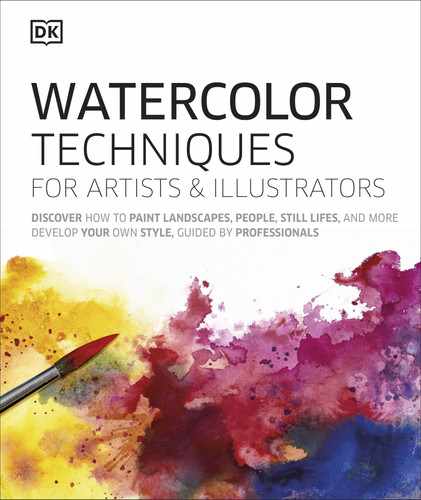
70 Beginner | TECHNIQUES
New Mosque, Istanbul
PUTTING IT INTO PRACTICE
In this view of Istanbul, at washes were applied
to give solidity to the building, contrasting with
the lighter sky. Visual interest is created by varying
the tone of the at washes from light to dark.
No. 10 and no. 2 soft-hair round brushes
Masking uid and craft paintbrush
20 x 13 in (51 x 32 cm) cold press
140 lb (300 gsm) watercolor paper
You will need
Neutral tint
Light red
Raw sienna
Indian yellow
Cobalt violet
Ultramarine
violet
French
ultramarine
Phthalo blue
(green shade)
Alizarin
crimson
Sap green
Flat wash
APPLYING SMOOTH COLOR
A fundamental technique to master in
watercolor is applying smooth layers of
color that dry to an even tone. Flat washes
can represent large areas such as sky or
water, and dene architecture and features
in a landscape. A smooth, at layer is also
a good base for adding details in darker
mixes, or building layers to vary the tone.
Laying a at wash
Use a soft-hair brush or a large synthetic-ber brush
that will hold the most paint. Before you start, make
sure that you mix sufcient colors—there is nothing
worse than running out of a particular mixture before
the wash is complete. Try not to stop in the middle of
laying a wash, as any variation in application could lead
to patches or stripes showing as the wash dries. When
the wash is complete, leave the paper to dry.
Continue to paint
across the paper in the
same direction
Beads of wash form
on the lower edge of
each stroke
First stroke
Hold the paper at a shallow
angle (around 30º), so that the
paint retains a wet lower edge.
Load the brush fully and start
at the top, painting across the
paper in one continuous stroke.
Blending brushstrokes
Reload the brush, pick up the
wet edge, and blend it smoothly
into the next stroke. Continue,
keeping the brush well loaded
so that you can cover an area
quickly and evenly. Absorb any
excess at the bottom with a dry
brush or paper towel.
2
Add mid-ground
color
When the sky wash
is dry, lay a at wash
of solid color to the
building. Start at the
top of the minarets and
lay the wash within the
outline in one smooth
area. Apply the rst
layers of wash for the
vehicles and road.
1
First layer
Lightly sketch the
outlines of the main
composition and mask
any areas that are to
remain unpainted with
masking uid, and leave
to dry. Apply a sky
wash in loose patches
from top to bottom, and
on the road, leaving
white for the clouds,
buildings, and vehicles.
US_070-071_Flat_wash.indd 70 02/04/2020 3:34pm

71 Flat wash
3
Dene features
Lay a third wash
over the building to
dene the larger
features and separate
each facade. Use
darker values to
accentuate the
domes and rooine.
The contrast of
color with the
bright taxis adds
foreground interest.
4
Dark details
Working over
the at wash, use a
darker neutral mix
to add details to
the buildings. The
windows and doors
create a sense of
scale with the darker
details of bushes and
cars, drawing the eye
into the composition.
5
Rene foreground features
In the nal stage, add the darkest shadows and
features. The strong shadows of the vehicles have
several colors of the same tonal value (see pp.66–67)
to suggest reected light and avoid them looking at.
“Watercolor
lightens as it dries,
so apply a darker wash
than you think.”
White highlights are reserved
with masking uid
US_070-071_Flat_wash.indd 71 02/04/2020 3:34pm
..................Content has been hidden....................
You can't read the all page of ebook, please click here login for view all page.
